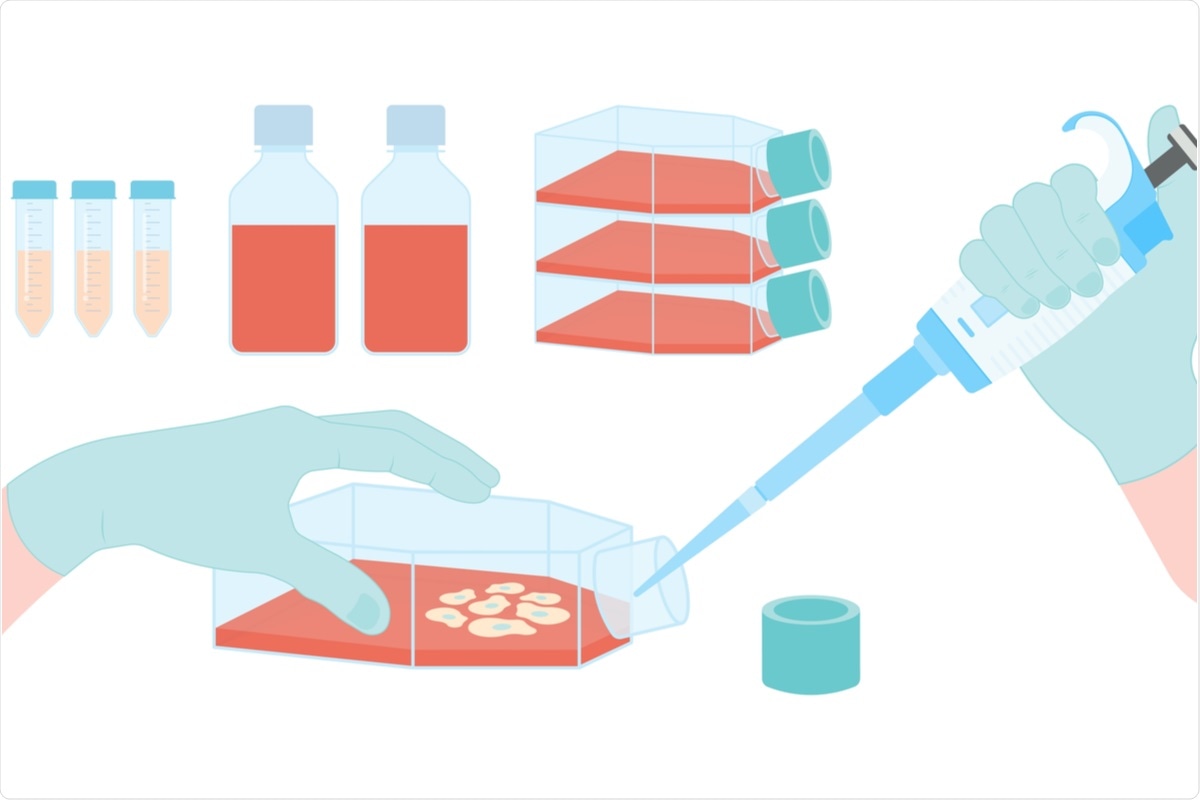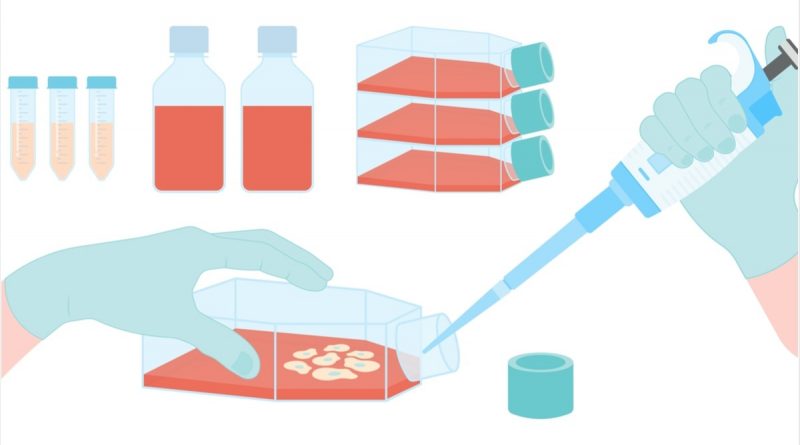SARS-CoV-2 infection model generated from human tonsil epithelial organoids
In a recent Biomaterials study, researchers evaluate the feasibility of tonsil epithelial cell-derived organoids as an ex vivo model for studying severe acute respiratory syndrome coronavirus 2 (SARS-CoV-2) infection.

Study: Generation of human tonsil epithelial organoids as an ex vivo model for SARS-CoV-2 infection. Image Credit: rumruay / Shutterstock.com
Background
A suitable ex vivo SARS-CoV-2 infection model system is an indispensable tool that could be used to assist in the development of broad-spectrum antivirals and universal vaccines, or for understanding SARS-CoV-2 pathogenesis in a personalized manner.
Several previous studies have used human pluripotent stem cell (hPSC)-derived organoids, as well as human intestinal, liver ductal, lung, and brain organoids, and demonstrated their utility in studying antiviral activity or tissue susceptibility.
Due to the limited availability of human tissues from open surgeries, there is a dire need to establish an alternative organoid system. These organoids should use human tissues that are readily accessible, can be maintained for a prolonged time, and allow robust SARS-CoV-2 replication through multiple rounds of infection.
From a clinical perspective, tonsils appear as good source material for alternative organoids due to their susceptibility to diverse respiratory viruses, including influenza virus and SARS-CoV-2. Unfortunately, a tonsil organoid model is difficult to culture and maintain stability over the long-term serial passaging. Mice and hamsters are also not available for their optimization, as they do not have orthologous organs.
About the study
As organoids are composed of several diversified differentiated cell types, they remarkably reconstitute the physiological conditions of human organs. In the present study, researchers establish tonsil epithelial cell-derived organoids using advanced technologies to evaluate their feasibility as an ex vivo model for SARS-CoV-2 infection.
This organoid model consisted of several stratified squamous epithelial layers and appropriate distributions of tonsillar biomarkers, such as angiotensin-converting enzyme 2 (ACE2) receptor, transmembrane protease serine 2 (TMPRSS2), and furin, all of which are essential for SARS-CoV-2 infection.
Consequently, SARS-CoV-2 was vigorously amplified through multiple rounds of infection, resulting in abundant secretion of progeny viral particles. The researchers also evaluated the therapeutic efficacy of remdesivir in the tonsil organoid model.
Tonsillectomies were performed to collect whole tonsils from 37 donors, which were subsequently maintained in saline. These tissues were cultured in advanced DMEM/F12 media supplemented with antibiotic–antimycotic, Glutamax, 10% conditioned media from Cultrex HA-R-spondin1-Fc 293T cells, and several growth factors to obtain organoids.
The researchers performed a clonal organoid formation assay on cells isolated by fluorescence-activated cell sorting (FACS). Tonsil epithelial organoids containing 6 × 104 cells at day seven of passage two were suspended at 37 °C for one hour in 5 μL TeM for infection with the same volume of SARS-CoV-2 at a multiplicity of infection (MOI) of 0.1 or 1. Supernatants were collected at three, 24, 48, and 72 hours post-infection for viral ribonucleic acid (RNA) quantification or infectious viral titration.
The researchers also performed histological and immunofluorescence microscopic examinations of the organoids. Microarray analysis was used to analyze the genetic similarity between tonsil tissues, crypt or surface, and organoids or whole-genome expression changes resulting from SARS-CoV-2 infection.
Finally, transmission electronic microscopic (TEM) analysis was used to observe the ultrastructure of tonsil organoids or the release of progeny SARS-CoV-2 particles from infected organoids.
Study findings
Flow cytometric analysis revealed that tonsil organoids cultured in TeM media were generated from epithelial cell adhesion molecule (EpCAM+) cells, thus verifying their epithelium-like properties. FACS analysis indicated the expression of the three molecules including CD44, integrin alpha 6 (ITGA6), and nerve growth factor receptor (NGFR), all of which are required for differentiation and maturation of tonsil epithelial cells into organoids.
The histological data suggested that tonsil organoid maturation was successfully achieved from a single cell of tonsil tissue, yielding a highly ordered stratified epithelium within 15 days in TeM.
The basal layer cells of tonsil surface or crypt epithelium expressing NGFR, ITGA6, or CD44 were localized on the outer side of the organoids between days 10 and 15. Comparatively, mucin 1 (MUC1)-expressing cells were localized in the inner domain of tonsil organoids.
High-throughput data from 21,448 genes showed high correlation coefficients between crypt and surface samples from the same donor, with r values of 0.96 for donors 21–33 and 0.97 for donors 21–36. Even between the two donors, this gene expression profile was well correlated, as demonstrated by r values greater than 0.91.
Interestingly, the tonsil organoids showed donor-independent homogeneity (r = 0.98) with relatively reduced correlation coefficient values, ranging from 0.75 to 0.80, to the tissue samples. Overall, gene expression profiles became further synchronized when tonsil epithelial cells matured into organoids.
Although overall gene expression of tonsil organoids overlapped with that of tissues, the principal component analysis (PCA) showed that messenger RNA (mRNA) expression of 88% of PC1 genes was similar between organoids and tissues. However, in 8% of PC2 genes, organoids showed a distinctive cluster from crypt and surface tissue samples.
Overall, the data confirmed that the tonsil epithelial organoids could exhibit their innate immune machinery in the presence of a toll-like receptor 4 (TLR4)-stimulating pathogen-associated molecular pattern (PAMP), similarly to tonsil tissues.
Conclusions
According to the authors, this is the first study to report the generation of human tonsil epithelial organoids for their feasibility as an ex vivo model to study infection by SARS-CoV-2.
The study also explored and highlighted immunological tripartite crosstalk between tonsil epithelial cells, immune cells, and SARS-CoV-2, thereby providing insights into the host defense mechanisms from the perspective of both innate and adaptive immunity and also of viral immune evasion strategies.
From a clinical perspective, tonsils are readily accessible, as they are specimens that are frequently underutilized after surgery. Overall, tonsil epithelial organoids are an attractive ex vivo model for applied and fundamental research on SARS-CoV-2 and other pathogenic viruses.
- Kim, H. K., Kim, H., Lee, M. K., et al. (2022). Generation of human tonsil epithelial organoids as an ex vivo model for SARS-CoV-2 infection. Biomaterials. doi:10.1016/j.biomaterials.2022.121460.
Posted in: Device / Technology News | Medical Science News | Medical Research News | Disease/Infection News
Tags: ACE2, Angiotensin, Angiotensin-Converting Enzyme 2, Antibiotic, Assay, Brain, Cell, Cell Adhesion, Cell Sorting, Coronavirus, Coronavirus Disease COVID-19, Cytometric Analysis, Efficacy, Enzyme, Ex Vivo, Fluorescence, Gene, Gene Expression, Genes, Genetic, Genome, Growth Factor, immunity, Influenza, Liver, Microarray, Molecule, Nerve, Organoids, Pathogen, Receptor, Remdesivir, Research, Respiratory, Ribonucleic Acid, RNA, SARS, SARS-CoV-2, Serine, Severe Acute Respiratory, Severe Acute Respiratory Syndrome, Surgery, Syndrome, Tissue Culture, Titration, Tonsil, Virus

Written by
Neha Mathur
Neha is a digital marketing professional based in Gurugram, India. She has a Master’s degree from the University of Rajasthan with a specialization in Biotechnology in 2008. She has experience in pre-clinical research as part of her research project in The Department of Toxicology at the prestigious Central Drug Research Institute (CDRI), Lucknow, India. She also holds a certification in C++ programming.
Source: Read Full Article



